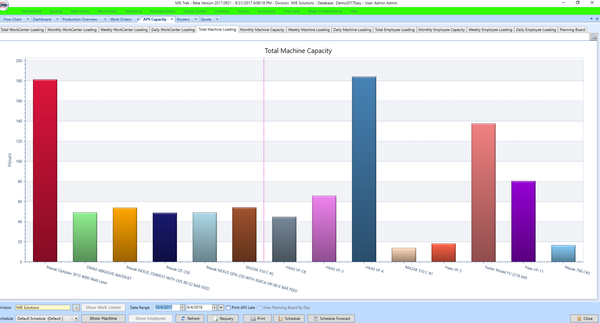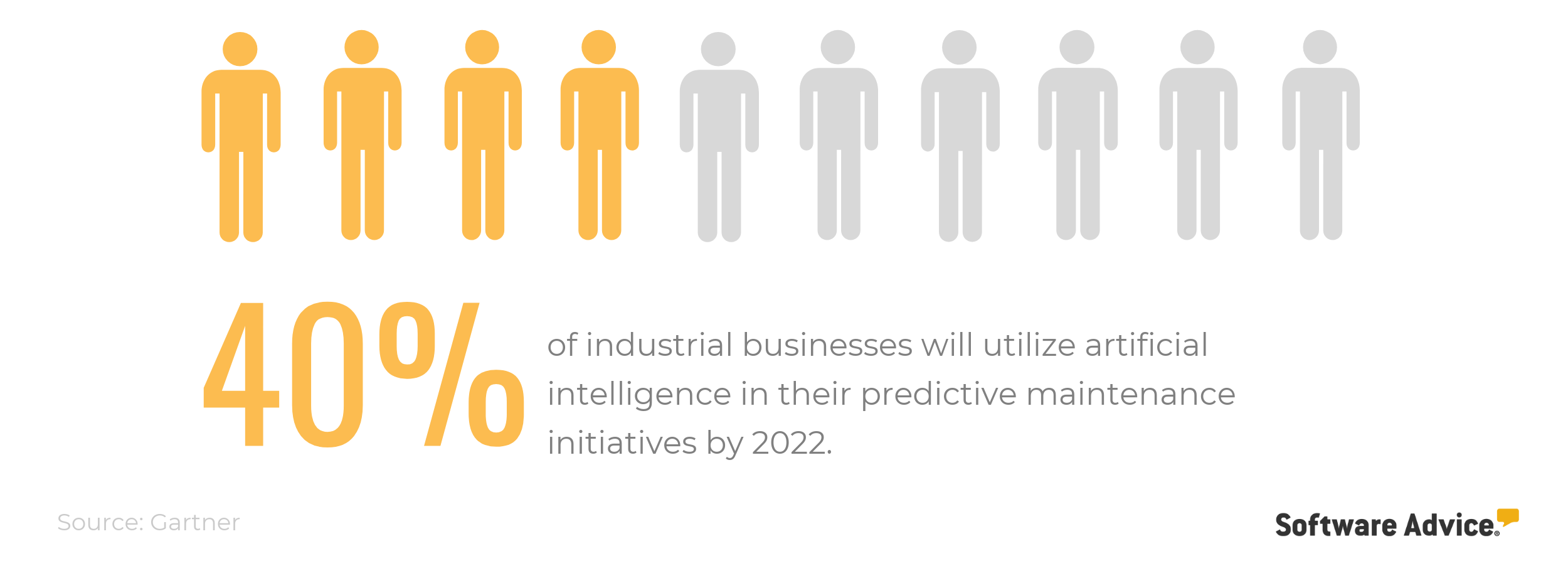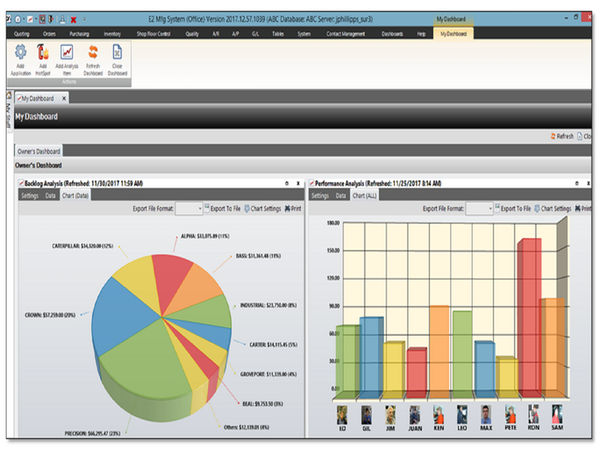How ERP Data Analytics Improve Predictive Maintenance
In the manufacturing business, downtime means frowntime.
A study by the International Society of Automation estimates $650 billion in downtime-related losses for the global manufacturing industry.
Why is this happening?
For starters, many small and midsize manufacturers aren’t fully utilizing their ERP software’s predictive maintenance and analytics tools, wasting unnecessary dollars on after-the-fact repairs. Such repairs cost businesses 50 percent more than maintenance of the predictive variety.
So, how can an ERP help? The answer is simple:
By giving manufacturers real-time data analytics and forecasting capabilities, ERP software’s predictive maintenance components can save as much as 40 percent on repair costs and help eradicate unplanned downtime.
An ERP’s predictive maintenance component helps manufacturers:
Increase Responsiveness With Real-Time Equipment Monitoring
Automate Service Procedures With Artificial Intelligence
Leverage Big Data for Deeper Insights
Let’s take a closer look at each aspect.
Increase Responsiveness With Real-Time Equipment Monitoring
As internet of things (IoT) technologies become more prominent, they’re taking a central role in manufacturing by way of real-time equipment monitoring. This capability, supported by IoT’s integration with mobile and cloud-based technologies, gives businesses unprecedented visibility into the health of their assets.
Manufacturers are understandably smitten; Gartner projects that by 2022, IoT-enabled predictive maintenance spending will rise to nearly $13 billion, almost four times the amount spent in 2018 (full report available to clients).
Through ERP software’s equipment monitoring element, manufacturers can transition from reactive to proactive maintenance initiatives. They can do this by:
Tracking the utilization rates of each individual piece of equipment and schedule maintenance once it passes a certain threshold.
Anticipating downtime and reallocate resources to minimize potential dips in production.
Analyzing the frequency and duration of equipment repairs to identify common problems and opportunities for improvement.


Machine capacity metrics in MIE Trak Pro ERP (Source)
EXAMPLE: A remote field service technician can receive alerts through their mobile device when a particular asset is due for repair, whether a result of usage (e.g., a machine’s millionth rotation) or prior maintenance date (e.g., six months after last repair).
Through the mobile app, they can then analyze usage data spanning the entire life of the machine—things like warranty information, work order history and service dates—before scheduling new maintenance on the asset.
Automate Service Procedures With Artificial Intelligence
Artificial intelligence is the future of ERP. Whether it’s automating routine processes or offering deeper insights into ERP data, AI’s transformative efficiency and analytical enhancements are a boon for manufacturers.
The same applies to predictive maintenance, too: Gartner predicts that 40 percent of industrial organizations will utilize AI-enabled predictive maintenance by 2022, a 400 percent increase from 2018 (full report available to clients).

Through artificial intelligence, manufacturers can reduce maintenance costs by as much as 40 percent while cutting downtime in half.
Repairing a broken asset after the fact costs 50 percent more than fixing it before it breaks down. But through AI-enhanced predictive maintenance, manufacturers can set automatic service reminders, order replacement parts and even notify stakeholders of any potential delays—all through automation that’s customizable and instantaneous.
EXAMPLE: A manufacturer looking to minimize on-the-job injuries can use their ERP’s automated maintenance tools to not only carry out the aforementioned tasks, but also inform employees from that department when a particular machine is scheduled for maintenance.
This way, workers on the shop floor can work around any potential disruptions or delays, with peace of mind in knowing that all equipment permitted for use meets only the most stringent safety measures.
Leverage Big Data for Deeper Insights
Big Data isn’t just a buzzword—its impacts are tangible, and they’re already being felt.
In the manufacturing sector, ERP data provides cross-departmental insight into the health of a business, up to and including predictive maintenance analytics. A single asset repair has far-reaching effects, from inventory adjustments to a likely decrease in production—all of which can affect your bottom line.
By streamlining all that data into an ERP system—in a way that eliminates duplicate data points and standardizes units of measurement—businesses can see how granular maintenance jobs influence the broader whole.
Predictive maintenance is more than just anticipating repairs; it’s also recognizing opportunities to improve and refine your decision-making process based on hard, actionable data.


Analytics dashboard in E2 Manufacturing System (Source)
EXAMPLE: A smartphone accessory manufacturer can use data analytics to identify which pieces of equipment most frequently need repairs, down to the individual product that is affected by delays. It can then use ERP’s advanced analytics to more adequately assess the machine’s average lifespan, adjust the process for scheduling repairs and even identify the potential cost savings from tweaks to the methodology.
Here’s the best part: As the data analysis becomes more efficient and profitable, so too will other parts of the manufacturing process, from product assembly to the finished product’s distribution.
Next Steps: Turning Predictive Maintenance Into Profitability
Now that you know how predictive maintenance can help your bottom line, it’s time to put that knowledge into action.
Here’s what you can do right now to put your business on the path to predictive prosperity:
Assess your current ERP’s predictive maintenance capabilities. Before taking the plunge and buying a shiny new ERP system, first determine whether your existing software’s predictive maintenance tools can adequately meet the needs of your business.
Most systems come with at least some form of job scheduling and data analytics components, but be sure to research how your vendor currently leverages AI and other future-forward technologies, and whether future updates will expand on those capabilities. You can also check out our list of more than 150 ERP products to assess how each is tackling predictive maintenance.
Stay informed of market developments. The ERP landscape is constantly changing, as the space continues to mature and present new opportunities for manufacturers. We continually talk about these advancements over on our resources page, so that’s a solid place to start, but you should also talk to your ERP vendor about how automation and other market developments are impacting their product.
Give us a call. Our knowledgable software advisors are always at the ready, armed with insights into an array of ERP solutions and the unique predictive maintenance features within them. For a free 15-minute phone consultation complete with a detailed needs assessment and software recommendations tailored to your business, give us a shout at (844) 680-2046.
Note: The information contained in this article has been obtained from sources believed to be reliable. The applications selected are examples to show a feature in context, and are not intended as endorsements or recommendations.